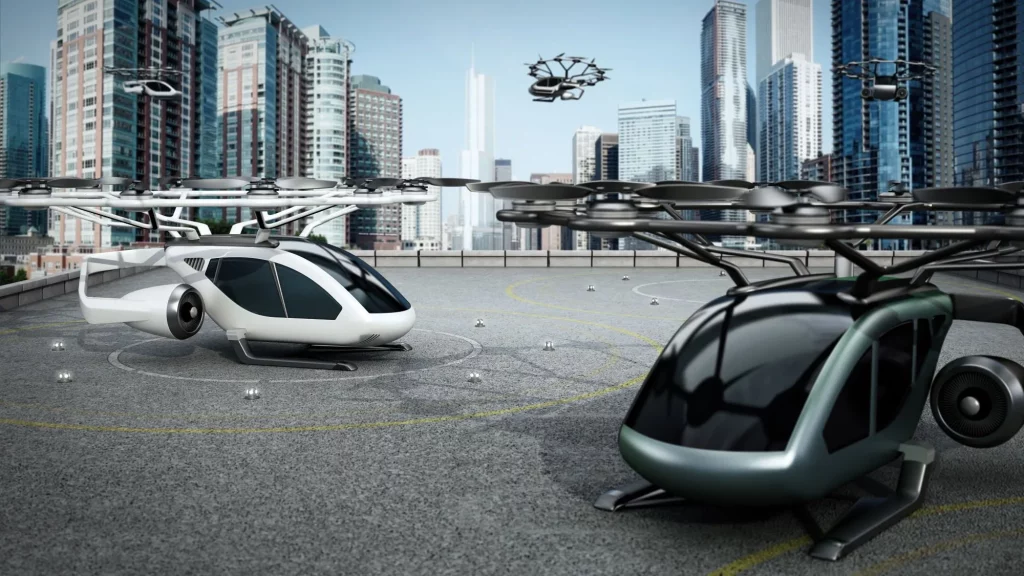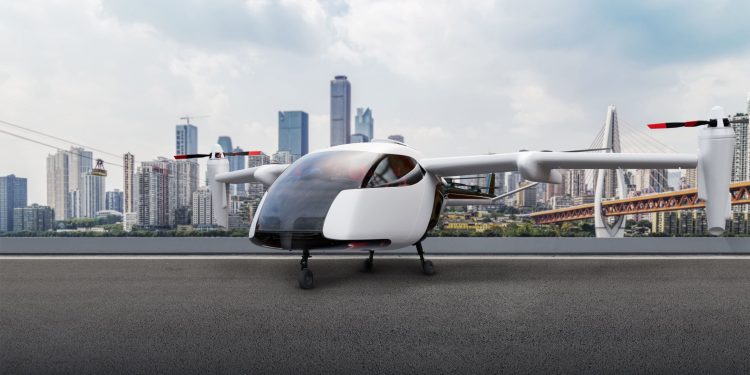Introduction: A New Era in Urban Transportation
For centuries, humanity’s relationship with the sky has been one of fascination, aspiration, and innovation. From the Wright brothers’ first flight to the rise of commercial aviation, the skies have long symbolized progress and freedom. Yet, in the 21st century, a new revolution is quietly taking shape above our cities — Urban Air Mobility (UAM).
Urban Air Mobility represents the convergence of aerospace engineering, digital intelligence, and sustainable energy. It envisions a future where small, electrically powered vertical takeoff and landing aircraft (eVTOLs) shuttle passengers and goods across dense urban centers, bypassing traditional traffic congestion and fundamentally redefining how people move. As cities expand and ground transport infrastructure reaches its physical limits, UAM offers an unprecedented opportunity to reimagine urban mobility — both literally and figuratively — from above.
This essay explores the technological, infrastructural, and systemic frameworks required to make UAM a practical reality. It examines the ecosystem of stakeholders, the challenges of integration, and the vision of a connected aerial network that can safely coexist with the urban fabric below.
1. The Genesis of Urban Air Mobility
Urban Air Mobility did not emerge overnight. It is the product of decades of evolution in aviation technology, autonomy, and electric propulsion. Traditional helicopters have long offered vertical lift capabilities, but their noise, fuel consumption, and operational cost have limited widespread adoption. The introduction of lightweight materials, battery energy density improvements, and electric propulsion has made it feasible to design smaller, cleaner, and quieter aircraft suitable for short-distance urban travel.
The idea of “flying taxis” has gained traction in recent years, fueled by rapid progress in drone technologies and the commercial success of unmanned aerial systems (UAS). Companies like Joby Aviation, Archer, Lilium, and Volocopter are pioneering eVTOL aircraft that combine helicopter-like vertical takeoff with airplane-like horizontal efficiency. At the same time, technology giants such as Uber Elevate (now Joby) and Airbus UAM are developing integrated ecosystems that connect air and ground networks.
From a systems perspective, UAM represents the next step in the “Third Dimension of Mobility”, complementing existing road and rail infrastructure with a new layer of aerial connectivity.
2. The Technological Foundations
To make UAM viable, several core technologies must converge: propulsion, energy storage, digital communication, and autonomy.
2.1 Electric Propulsion and Battery Systems
Electric Vertical Take-Off and Landing (eVTOL) aircraft rely on high energy density batteries, lightweight composite materials, and distributed propulsion systems. Advances in solid-state batteries, silicon-anode cells, and hybrid propulsion are extending flight ranges and reducing charging times. The goal is to achieve high efficiency with minimal environmental footprint.
2.2 Autonomy and Artificial Intelligence
Autonomous navigation systems are at the heart of scalable UAM operations. AI-driven flight control, obstacle detection, and route optimization enable multiple aircraft to safely operate in complex urban airspace. Machine learning algorithms continuously adjust flight patterns to minimize energy consumption and maximize safety.
2.3 Communication and Air Traffic Integration
The digital backbone of UAM lies in 5G and satellite-enabled networks. Low-latency communication ensures real-time coordination between aircraft, vertiports, and ground control systems. Emerging concepts such as U-space (Europe) and UTM – Unmanned Traffic Management (U.S.) aim to create digital corridors in the sky — structured, data-driven airways optimized for safety and efficiency.
3. The Infrastructure of the Sky
While UAM aircraft capture public imagination, the real challenge lies in building the infrastructure that supports them.
3.1 Vertiports: The Airports of the Future
Vertiports serve as the landing, takeoff, and charging nodes of the UAM ecosystem. They are envisioned as modular, scalable hubs that can be integrated into existing rooftops, parking structures, or dedicated sites. Key design priorities include passenger flow, safety protocols, and seamless integration with ground transport systems.
3.2 Power and Charging Networks
To support electric flight, cities must deploy high-capacity charging infrastructure powered by renewable energy sources. Smart grids, on-site energy storage, and load balancing systems ensure reliable power delivery during peak operational hours.
3.3 Data Infrastructure and Airspace Design
Unlike roads, airspace lacks physical boundaries. This requires advanced geofencing, 3D mapping, and digital twin modeling to manage safe navigation corridors. Cities will need virtual air highways with dynamic traffic zoning to avoid congestion and maintain air safety.
4. Integration Challenges
The transition to UAM will not be seamless. It involves significant technical, social, and regulatory challenges.
4.1 Safety and Certification
Safety remains the top priority. Regulatory agencies such as the FAA (Federal Aviation Administration) and EASA (European Union Aviation Safety Agency) are developing certification frameworks to evaluate eVTOL designs, pilot training, and maintenance standards. Achieving public trust will require extensive safety testing and transparent communication.
4.2 Public Acceptance and Noise Management
Public perception is as important as technical feasibility. Communities must feel that UAM improves quality of life rather than disrupts it. Noise pollution, visual intrusion, and privacy are all sensitive issues. Manufacturers are experimenting with low-decibel rotor configurations and adaptive routing algorithms to reduce urban noise impact.
4.3 Economic Viability
Early UAM services will be expensive. Initial deployment will likely target premium routes (e.g., airport-to-downtown transfers) before scaling to broader accessibility. Over time, cost reductions from manufacturing economies of scale and autonomous flight could democratize access.

5. The Ecosystem of Stakeholders
UAM is a system-of-systems, requiring collaboration between multiple actors:
- Aerospace Companies — design and produce aircraft.
- Urban Planners — integrate vertiports into existing cityscapes.
- Telecommunication Providers — build the digital networks for connectivity.
- Energy Companies — ensure sustainable power sources.
- Policy Makers and Regulators — establish safety and certification frameworks.
- Public and Communities — provide social license to operate.
The success of UAM depends on forming a public–private partnership model, where innovation and governance advance together.
6. Sustainability and Urban Impact
One of UAM’s most compelling promises is environmental sustainability. Electrification reduces direct emissions, while efficient aerial routing can alleviate road congestion. However, sustainability requires a holistic approach — aircraft manufacturing, energy sourcing, and battery recycling must all align with green principles.
Urban air mobility could also reshape spatial economics. By reducing travel time between districts, it may decentralize city cores, promote new urban hubs, and influence real estate values. The implications for city planning are profound.
7. Future Outlook: The Skies of 2040
By 2040, experts project that UAM could become an integral part of urban transportation networks. In mature cities like Singapore, Dubai, and Los Angeles, autonomous eVTOL taxis may provide on-demand aerial rides within dedicated corridors. Freight drones will complement human transport by delivering goods, while air ambulances enhance emergency response.
Beyond practical transportation, UAM embodies a symbolic shift: it redefines human perception of urban space. The city is no longer confined to two dimensions — it extends vertically, dynamically, and intelligently.
Conclusion: Building the Sky City
Urban Air Mobility represents more than a technological innovation; it is a redefinition of civilization’s relationship with movement, energy, and urban life. As we prepare to inhabit the skies, the success of this transformation depends not only on engineers or policymakers but on a collective imagination — a belief that cities can evolve upward as well as outward.
The future city will not merely be smart; it will be aerial — a living organism of interconnected systems where humans, machines, and skies coexist in harmony. The sky revolution is not coming; it has already begun.











































